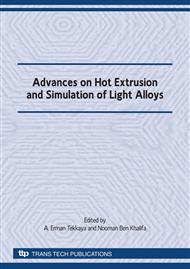p.213
p.221
p.227
p.235
p.241
p.249
p.257
p.265
p.273
Prediction of the Extrusion Load and Exit Temperature Using Artificial Neural Networks Based on FEM Simulation
Abstract:
In the present study, the extrusion process for the AZ31B magnesium alloy was simulated using a DEFORM-3D software package to establish a database in order to provide input data for artificial neural networks (ANN). The network model was trained by taking extrusion ratio, ram speed, shape complexity and ram displacement as the input variables and the extrusion load and exit temperature as the output parameters. The data from FEM simulations were submitted for ANN as a training file and then ANN built were used to predict the target parameters. The ANN predicted results were found to be in agreement with the FEM simulated and experimental measured ones.
Info:
Periodical:
Pages:
241-248
Citation:
Online since:
December 2009
Authors:
Price:
Сopyright:
© 2010 Trans Tech Publications Ltd. All Rights Reserved
Share:
Citation:


